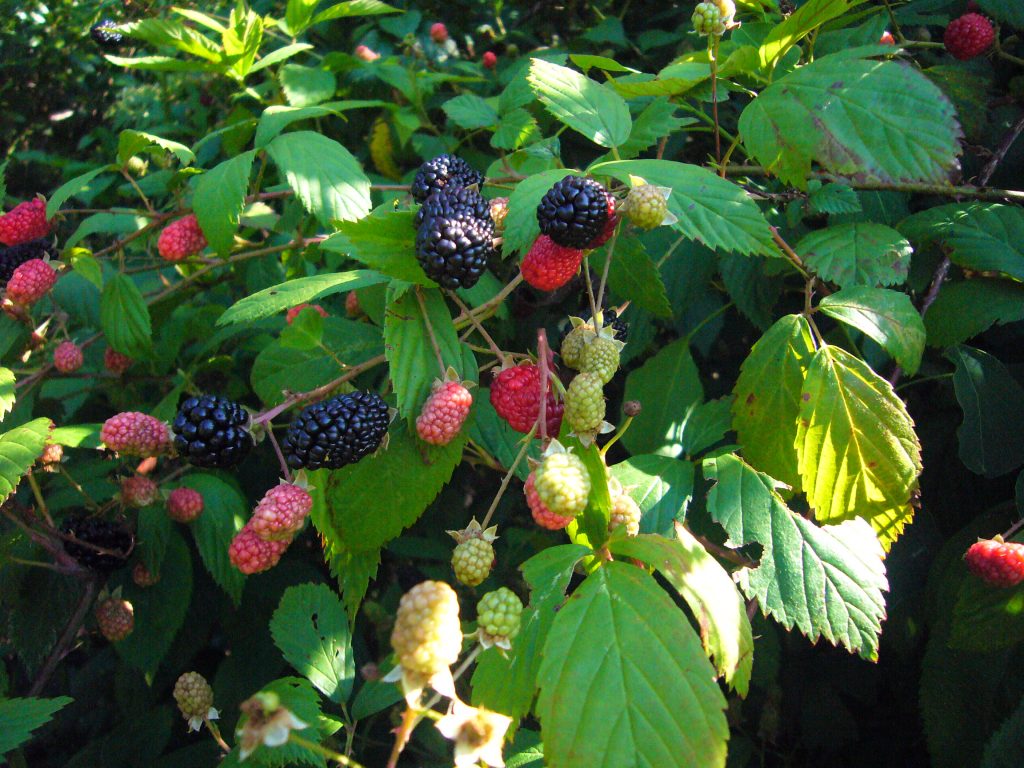
Blackberries are in transition. Photo by Green Deane
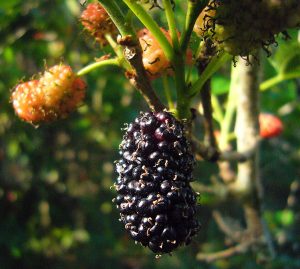
Mulberries resemble over-grown blackberries. Photo by Green Deane
Blackberries seems to be behind schedule this year. Usually by mid-April one can find many ripe blackberries.However right now they seem half ripe, It’s the same with mulberries which by now are usually dark purple and sweet. Blue berries are ripening but we did not find any totally ripe ones this past weekend. Also by now one usually can find some early ripening black cherries The season seem to be a few weeks off. This usually means terrestial mushroom season will be late. It usually follows 10 days to two weeks of rain in May. On the comfort side we should be past really cold snaps. just a few cooler days on the full moons. Going out of season are loquats.
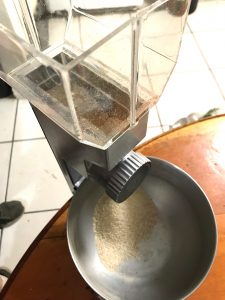
Hand-grinding wheat berries. Photo by Green Deane
I spent a good part of this week practicing for Hurricane Putin by grinding wheat berries (grain) into flour. My nickel-plated cast iron corn mill did not grind the wheat fine enough for flour. Even whole corn has to go through it twice for masa. Electric ginders are much faster… if you have electricity. So I bought a manual mill especially for wheat berries. It still required a double grind to get fine flour for my soudough bread.
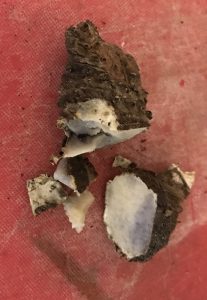
A roasted aquatic taro root. Photo by Green Deane
Worked on a perpetual problem you can read about here, and that is, is aquatic taro edible? I think the answer is no even though there are reports from Vietnam about cooking the leaves for pig fodder. We dug up a good sized corm in Mead garden. I roasted it for an hour at 350F. It was still laced with burning calcium oxalates and sneakedly so. Fine calcium oxalate crystal take a couple of minutes to attack, so you have to try the material and definitely wait a few minutes. Don’t succumb to initial absence of burning to mean it is edible I did not have the usual antidote on hand, lime juice or lemon juice. I resorted to vinegar. I then soaked some of the cooked corm in water as the Aboriginal do in Australia. Still burning. Some fermented pieces were still peppery after a week of fermenting. That only leaves long-term dry heat as a possibe method of preparation, such as burying the corms under a camp fire for days to make them edible.
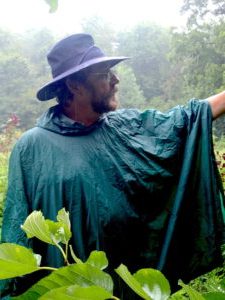
Classes are held rain or shine (but not during hurricanes.)
Only one foraging class this weekend in Port charlotte. No class on Sunday as I am bicyling 50 miles in a charity ride in Venice.
Saturday April 23rd, Bayshore Live Oak Park, Bayshore Drive. Port Charlotte. 9 a.m. to noon, meet at the parking lot of Ganyard St, and Bayshore Blvd.
Saturday April 30th, Jervey Gantt Recreation Complex, 2390 SE 36th Ave., Ocala, FL, 34471.9 a.m. to noon. Meet at the entrance to the pool, aka Aquatic Fun Center. To meet the demands of the city of Ocala, this is a free class, If you want to make a donation afterwards that is at your discretion.
Sunday May 1st, Wickham Park: 2500 Parkway Drive, Melbourne, FL 32935-2335. 9 am. to noon meet at the dog park inside the park.
Saturday/Sunday May 7th & 8th, Honea Path, South Carolina, classes at 9 a.m. and 1 p.m. each day.
Saturday May 14th Dreher Park, 1200 Southern Blvd., West Palm Beach, 33405. 9 a. m. to noon Meet just north of the science center.
Sunday may 15th, Mead Gardens, 1500 S. Denning Dr., Winter Park, FL 32789. 9 a.m. to noon Meet at the bathrooms.
For more information, to pre-pay or sign up go here
Watercress/Wintercress grew in a ditch behind an apartment complex I lived in near Sanford, Florida, some 30 years ago. How did the Eurasian native Nasturtium officinale, get there? It came to North America with the Europeans, found a good home, and stayed. Alabama became the epicenter of cultivating it then later Central Florida. The city of Sanford, by the way, is named for Henry Sanford one of Lincoln’s ambassadors. He is called “General Sanford” but the gentleman never served in the military. He got the title for donating a cannon to the Union effort. Sanford was, however, big on big farming and for a few decades made the city of Sanford the big place to go in Central Florida not Orlando.
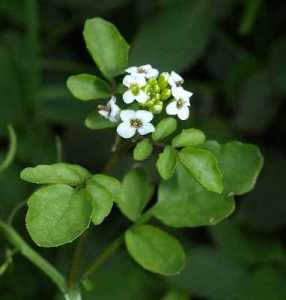
When President Calvin Coolidge came to Central Florida in 1929 it was to Sanford he went not little-ol’ backwater Orlando. The city of Sanford had everything: River, rails and road. But it lacked leadership giving Orlando a chance to make its mousey mark. As Coolidge did so did watercress which is why it ended up in the ditch behind the apartment complex in Sanford. The entire area was truck farms and one of their winter crops was watercress. Peppery like nasturtiums it is edible raw or cooked but make sure you get it from wholesome water. Nasturtium by the way literally means “twisted nose.” Where I collect watercress to be eaten raw is about a half mile down stream from the Wekiva River boil (its main spring and headwater.) But there’s a lot of water hemlock around so I have to pick carefully. To read more about watercress go here. To read about the deadly Water Hemlock go here.

Green Deane videos are now available on a USB.
My nine-DVD set of 135 videos has been phased out and replaced by 171-videos on a 128-GB USB, see left. The USB videos are the same videos I have on You Tube. Some people like to have their own copy especially if social order falters. The USB videos have to be copied to your computer to play. If you want to order the USB go to the DVD/USB order button on the top right of this page or click here. That will take you to an order form. Or you can make a $99 donation, which tells me it is for the USB (include a snail-mail address.) I’d like to thank all of you who ordered the DVD set over the years which required me to burn over 5,000 DVDs individually. I had to stop making them as few programs now will read the ISO files to copy them. Burning a set also took about three hours.

Green Deane Forum
Want to identify a plant? Perhaps you’re looking for a foraging reference? You might have a UFO, an Unidentified Flowering Object, you want identified. On the Green Deane Forum we — including Green Deane and others from around the world — chat about foraging all year. And it’s not just about warm-weather plants or just North American flora. Many nations share common weeds so there’s a lot to talk about. There’s also more than weeds. The reference section has information for foraging around the world. There are also articles on food preservation, and forgotten skills from making bows to fermenting food. Recent topics include: Fermenting potatoeswith yogurt, make a water filter, nixtamalization at home, Stale Bread and Cod Liver Oil, Life’s a Grind, Killing Bugs with Tobacco Plugs, Eating weeds: Is it safe? Have they mutated? Not the Eastern Red Bug but the Pink Tabebuia, African Tulip Tree, Asparagus densiflorus, Green Deane’s Book… You can join the forum by clicking on the button on the upper right hand side of this page. This is my weekly newsletter #504. If you want to subscribe to this free newsletter you can find the sign-up form in the menu at the top of the page. My website, EatTheWeeds.com, which is data secure, has over 1500 plants on it in some 428 articles. I wrote every one myself, no cut and paste.
To donate to the Green Deane Newsletter click here.

